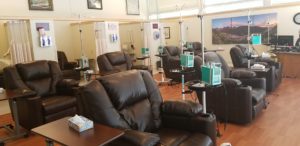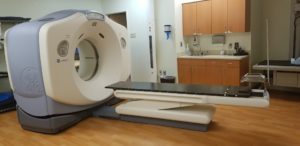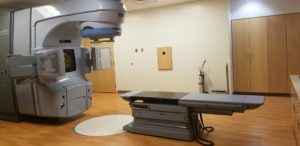I began my internship in Farmington, New Mexico at San Juan Medical Center. Throughout my internship, I was able to shadow different nurses and interact with some patients. Each day was spent in a different department, learning a variety of tasks and requirements. I stayed with Dr. Nguyen for the week. He specializes in radiation treatment for cancer patients.
Tuesday morning was the first day at the hospital. Dr. Nguyen and I started at eight, reviewing paperwork and patients’ diagnoses. Dr. Nguyen would look over each patient’s paperwork before seeing them. Several of the patients I met had different types of cancer, were at different stages, and needed different treatments. Once a week, the Tumor Board, those who specialize in cancer, come together at lunch to go over current patients, their type of cancer, and their treatment plan.
Dr. Nguyen and the nurses discussed the 3 step process: first is simulation. The patient has a CT scan to determine the size, shape, and location of the tumor. The CT scan can show the blood vessels, organs, bones, and tissues. This step takes less than thirty minutes. The second step is evaluation. Dr. Nguyen, nurses, and other doctors review the scan and determine the treatment necessary for the cancer. Treatment options are radiation (x-rays), chemotherapy (drugs/medication), or surgery. The length of evaluation varies with each patient; the doctors take their time and after discussion, treatment begins. Patients will come to the clinic for three to seven weeks, Monday through Friday. Radiation treatment lasts approximately 15-20 minutes per day and focuses on the cancer tumor.
Chemotherapy varies with each patient and each type of cancer. While I was at the clinic, some patients stayed for only thirty minutes, while other patients stayed over two hours. Chemotherapy affects cancer cells and also the normal, healthy cells. While damaging current cancer cells, it can also create cancer cells in other parts of the body. Chemo is either a single drug or a combination of drugs which prevents cell division. At the Chemotherapy Suit, Lauren, head of the chemo center, showed me how chemo was inserted into the patients through two methods: intravenous infusion and ambulant infusion. Intravenous infusion is injected directly into veins, typically the ones in the muscles in the arm or thigh. Ambulant infusion is a pump or portacath (a thin, soft, flexible plastic tube) which is inserted under the skin of the chest or arm. Passed the port is a catheter that leads directly to the heart.
On the morning of Day Two, I spent five hours in the Cardiac Cath Lab. An older man needed a cardiac ablation— a procedure that scars or destroys the tissue in the heart that triggers abnormal heart rhythm. Surgery lasts between three to six hours, not including time prepping. Prepping the patient involves placing an IV, giving sedative/general anesthesia, and inserting a sheath into the blood vessel. The doctor then uses catheters to destroy the muscle cells. Post surgery, the nurse puts pressure on the site (groin area) for fifteen minutes on each side, totaling thirty minutes. The patient then rests for approximately six to eight hours, depending on whether or not complications occur.
Another department I visited was Connelly Hospitality House. They provide stay for cancer patients who travel more than fifty miles to receive treatment. CHH heavily relies on donations from the community, companies, and online. There is a laundry room, library, dining room, pantry, kitchen, RV parking, and bedrooms. Across from the Connelly House is the Medical Foundation. The Medical Foundation raises funds for cancer patients who can receive $500 a year for medical bills. To qualify, they must have had cancer. The foundation holds events throughout the year and the money raised goes to patients.
For the rest of the day, I spent the afternoon in the emergency room. I shadowed several nurses who checked glucose levels for intoxicated patients, IVs, and vitals. After each patient, they would chart and send the collected information to the doctor. Staff was split up into groups and assigned certain sections of the ER. While waiting for a patient to arrive, a paramedic took me upstairs and showed me the emergency helicopter. He explained the difference between paramedics and nurses in the hospital.
On my last day, I was up bright and early to finish the week in OB. Two mothers were coming in to deliver, so we prepped her room which included cleaning, making the bed, setting up monitors for the mother and baby, and making sure we had enough supplies. While waiting for them to arrive, I watched a baby get a bath (he didn’t like it), and burped a baby after feeding. We then gave him his required medications, checked his vitals, and changed his diaper and blankets.
I spent the afternoon talking with a patient who has lymphedema, a result of swelling in the lymphatic system. Her lymph nodes were removed during cancer treatment, limiting the flow of liquids throughout the body. Cynthia discussed the causes of swelling and demonstrated the techniques to get rid of the discomfort along the sides of her body, arms, and legs. She compared her swelling to a dam; the liquids were stuck in one spot, then causing the rest of the river to be backed up. Putting a little pressure along her sides and in the armpit would relieve liquids and the dam would be opened up. When the patient went out, she could wear spandex to help reduce swelling and discomfort. The compression encourages lymph flow to the rest of the body.
My week at the Medical Center opened up many options for my future, helped me set a goal, and allowed me to learn a lot about this occupation and what it entails. I am very thankful for all of the doctors and nurses who volunteered their time to educate me more about working in the medical field. They showed me things I could never have imagined and taught me so much.




There are no comments published yet.